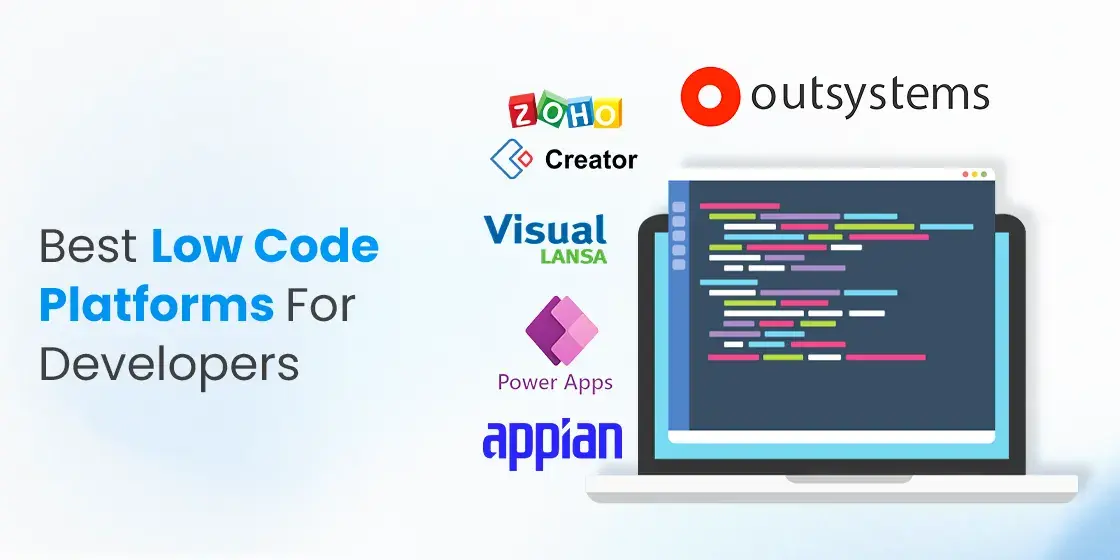New Facts On Deciding On Low-code platforms for application development
New Facts On Deciding On Low-code platforms for application development
Blog Article
The Benefits Of Low-Code Programming For Application Development In Relation To Pertains To Integration Capabilities
Low-code applications provide significant advantages in terms of integration, which is vital when developing applications that can seamlessly connect to various systems and service. Here are a few of the main advantages: Prebuilt Connectors and APIs
Wide Selection of Connectors. Low-code software typically includes a wide range of pre-built connections for enterprise systems that are popular (e.g. cloud-based services, databases, CRM). This makes it easier to integrate with these systems.
API Integration: Many low-code platforms come with API integration options, which allow developers to connect with external service and data sources easily.
Ease Of Use
Drag-and Drop Integration: Many integration tasks can be completed using drag-and drop interfaces. This allows developers and nondevelopers to create complicated integrations using little or no programming.
Visual Workflow Designers: These tools help you understand and configure integrations more easily.
Standardized Integration Methods:
SOAP/RESTful Service Support: Standard web services protocols, like SOAP/REST allow for the easy integration of a range of different systems and applications.
OData Standards and other Standards Support for standards, like OData provides easy access to data as well as its manipulation across different platforms and apps.
Real-Time Data Synchronization:
Low-code platforms permit real-time integration between systems as well as applications. This allows information to be updated and consistent in all areas of the business.
Event-Driven Architect: Some platforms are equipped with structures that are event driven, allowing applications to respond immediately to any event. This is important for interactive and dynamic applications.
Legacy System Integration:
Low-code platforms are frequently used to integrate legacy systems. This allows organizations to upgrade IT infrastructures without the need for a complete overhaul of existing systems.
Data Migration Tools: Built-in software helps transfer data from outdated applications to new ones built on platforms that use low-code.
Integration of third-party services:
Integration with Cloud Services: Seamless integration with cloud services like AWS, Azure, and Google Cloud allows for the easy deployment and scaling of applications.
Business Applications Integration: Low-code platforms are able to integrate with different business software like Salesforce, SAP, Microsoft Dynamics and more. This allows for a seamless workflow that is able to be used across various business processes.
Simplified Data Processing
Unified Data Models: Some platforms that use low-code provide unified data modeling which makes data integration easier and management across multiple platforms.
Data Connectors: Data connectors that are pre-configured to provide easy access and manipulation of data derived from various sources.
Security and Compliance
Low-code integration platforms comply with security standards to safeguard information while it is in transit or at rest.
These platforms are often equipped with features that in ensuring compliance (e.g. HIPAA, GDPR) and offer peace of mind to businesses dealing with sensitive data.
Extensibility:
Custom Code and Scripts: To meet more complicated integration requirements Low-code platforms typically permit the integration of custom code and scripts, providing flexibility without compromising accessibility of the.
Plug-in Ecosystem: An ecosystem of plugins and extensions can enhance the integration capabilities and allow users to add new functionalities as needed.
The overall low-code platform's integration capabilities make it a powerful instrument for developing interconnected apps which are scalable and efficient. These platforms streamline the process of integrating disparate IT systems, improve data flow, and help businesses to adopt the latest technologies and also make use of new ones. Read the recommended Low-code Platform for application development blog for more info including build a docker container, rad application development, rad development, developing mobile apps, mobile development platforms, rad application development, multiplatform mobile app development, sso azure, cross platform mobile app development, rapid app development and more.
Benefits Of Low-Code Application Development In Governance And Security
Low-code applications offer a number of advantages when it comes to security and governance, both of which are crucial to ensure that applications are safe as well as secure and properly managed throughout their lifespan. These are the major benefits.
Unified management console: Low-code platforms typically provide a centralized administration console where administrators manage all applications and ensure consistent governance within the organization.
Role-Based Access Control RBAC: These platforms are equipped with robust role-based controls that allow administrators to set access rules. Only authorized users will be permitted to modify and access specific areas of an application.
Compliance and Regulatory Application:
Built-in Compliance Features: Many low-code platforms are designed to conform to industry standards as well as regulations (e.g. GDPR, HIPAA). These platforms provide frameworks and tools to ensure that applications are in compliance with these regulations.
Audit Trails and Logging: Complete audit trails and logs can be integrated to allow organizations to track change, monitor access and ensure the compliance.
Additional Security Measures
Data Encryption Low-code platforms typically include built-in encryption of information in transit and at rest, protecting sensitive data.
Security Certifications A lot of low-code vendors have security certificates (e.g. ISO 27001, SOC 2 ) that demonstrate conformity to the highest security standards. This adds additional confidence for the customers.
Automated Security Updates
Regularly scheduled updates and patches: Low-code platforms typically manage regular patches and updates to security automatically, making sure applications are secure from most recent threats, without the need for manual intervention from developers.
Security Monitoring - Continuous monitoring for security is usually included. This provides real-time insights and alerts on potential security threats.
Data Governance
Data Access Policies: These software tools allow organizations to define the data access policies, enforce them and keep track of policies. This will ensure that the data is only accessible to authorized users and used in a proper manner.
Data Masking and Anonymization: Inbuilt tools for masking data and anonymization can help safeguard sensitive data, particularly in development and testing environments.
Consistent Lifecycle Management of Applications
Pipelines for development and deployment: Low-code platforms allow for integrated development, including security checks. This ensures security throughout the lifespan of an application.
Version Control - Integrated version controls help keep track of modifications to applications, and permits the application to be reversed, if required. They also ensure the integrity and quality of the software.
User Authentication & Authorization:
Single Sign-On (SSO). Support for advanced authentication and single sign-on is simple and enhances security.
Multi-Factor Authentication - Many platforms allow multi-factor Authentication that adds an extra layer of security when logging into applications.
Policy Enforcement Monitoring and Compliance:
Low-code platforms have policy templates predefined that can help organizations implement security and governance guidelines.
Compliance Monitoring Tools - These tools provide constant monitoring of compliance status and offer reporting, making it easy to spot and fix any issues that might arise.
Integration into Existing Security Infrastructure
Seamless Integrate: Low-code platform are designed to integrate seamlessly with the existing security infrastructure and tools, including identity management solutions SIEMs (Security Information and Event Management Solutions), and firewalls.
API Security: API security features that protect data and maintain the integrity of applications are built into the API.
Training and the best practices
Numerous platforms provide guides and best practice for secure application development. They can help developers who are not developers to adhere to security standards.
Security Training: Some providers of low-code software offer education and resources in security to educate users about how to design and develop secure applications.
The security and governance capabilities of low-code applications make sure that they are built and managed in a safe and secure way. These platforms are equipped with the frameworks, tools and regulatory compliance that are required to secure sensitive data of customers as well as enforce policies and ensure compliance with regulatory requirements and ease the administration and supervision over the application development process. Read the top Legacy application modernization with Low-code for blog examples including rapid action development, developing mobile apps, push notifications android, application development platforms, cross platform app dev, developing mobile apps, cross platform app development, push notifications, cross platform mobile app development, developing mobile apps and more.
Advantages Of Low-Code Application Development In Terms Of Limitations And The Possibility Of Customizing
Low-code application development is a well-balanced solution that provides significant benefits in dealing with limitations and permitting customization. These are the key advantages: Resolving Limitations
Removing Complexity Barriers
Simple Development : Low-code platform reduces complexity by providing templates and components that are pre-built, allowing for faster development and deployment.
A lot of platforms come with wizards and workflows that are guided to help developers navigate complicated procedures. These tools decrease the chance of making mistakes, and also help to ensure the consistency of.
Scalability Solutions
Built-In Scalability: Low-code platforms typically include features that allow the development of scalable architectures, which allows applications to handle higher load without major redevelopment.
Performance Monitoring: Tools which monitor and optimize performance assist to ensure that applications are efficient, even when they grow.
Security and Compliance
Integrated security features: Low-code platforms offer security measures such as encryption and access control based on role, and automated compliance checking that address the most common security issues.
Regular Updates: Platforms often change their security protocols and compliance procedures. This helps ensure that applications are safe from threats that are constantly evolving.
Customization capabilities:
Extensibility:
Low-code platforms permit developers to expand functionality beyond what is available by using customized code.
Developers can design custom modules and plugins that add functionality that are tailored to the specific requirements of a business.
APIs and Integration
API Support: The extensive API support permits seamless integration of other systems and services. This enables the ability to customize and connect.
Third-Party Service: Low-code platforms provide pre-built connectors to well-known third-party service providers. This makes it easy to integrate and customize applications.
Flexible Design for UI/UX
Customizable User Interfaces: Developers may modify and create user interfaces that comply with the specifications for branding and usability, creating a tailored user's experience.
Responsive Designs: The software can be customized to suit different sizes of screens and devices.
Making Business Logic more flexible is simple:
Visual Workflow Builds: Visual tools that permit the modification of workflows as well as business rules as well as to design complicated, tailored processes.
Conditional Logic & scripting: Platforms allow for the application of conditional logic and custom scripting for handling particular business rules.
Data Management:
Custom Data Models Developers can choose to develop custom data models specifically for particular applications, and tailoring the handling of data to the specific requirements of business.
Advanced Data Processing: Integration of advanced tools and capabilities for data processing permits customizations to the way data is processed in an application.
How to balance customisation with limitations:
Frameworks and Standards
Low-code platforms promote the use of industry-standards and best practices, resulting in applications of high-quality that are flexible and safe.
Governance Frameworks - Built-in governance frameworks ensure that customisations do not affect security, integrity, or adherence.
Iterative design and feedback:
Rapid Prototyping: The capacity to rapidly prototype and test changes allows developers to refine their applications based on feedback from users improving the app to better meet user needs.
Continuous Improvement: Platforms that use low-code support for continuous improvement which allow for customization and improvement as business needs evolve.
Empowering Users:
Low-code platforms enable citizen developers: By allowing non-developers, by using intuitive interfaces to modify applications, they broaden the pool of developers who can improve and customize applications.
Training and Support: Many platforms offer comprehensive training and support to assist users with effective customizations without compromising the stability of the application or its performance.
Low-code development is a potent framework that offers a wide range of customisation while addressing any issues. This balance allows companies to create and maintain applications that work and tailored to specific business needs. All while maintaining high quality, security scaleability, standards, and security.